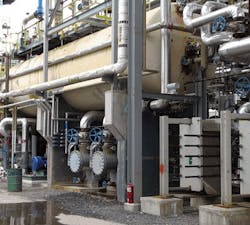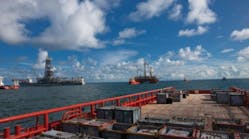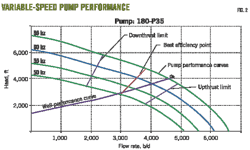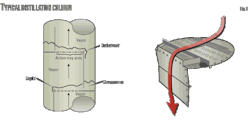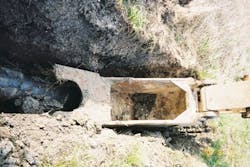This article reports on the investigation of low production of ultralow sulfur diesel (ULSD) at a middle distillate hydrotreating unit in the Lukoil Neftochim Bulgaria (LNB) refinery, in Bourgas, Bulgaria. Specifically, it focuses on problems arising from unreliable operation of the unit's heat exchangers.
The investigation reached two main conclusions:
1. A failure in the reliable operation of the heat exchanging equipment of a middle distillate hydrotreater can lead to a failure in the production of ultralow sulfur diesel and near-zero sulfur diesel.
2. The most reliable information proving the presence of a leak in a middle distillate hydrotreater heat exchangers is gas chromatography—atomic emission detector (GC-AED) analyses of the feed and product sulfur compound distribution. The presence of benzothiophenes in the product from the hydrodesulfurization (HDS) unit to as high as 99% would indicate a leak in the heat exchanging equipment.
Background
After extensive pilot plant tests in 2005 lasting 6 months, the Topsoe TK-576 Brim was selected in July 2005 as the best catalyst for this hydrotreater. During a cycle time lasting 11 months, the unit performed unsatisfactorily, prompting several tests to determine the reason for the poor performance.
The sulfur level in the hydrogenate varied in the range 40-80 ppm and operators observed no dependence of the weighted average bed temperature (WABT) on the product sulfur. Two possible reasons were a catalyst bypass or heat exchanger block leakage.
Tests with different liquid hourly space velocities (LHSV) showed good response of product sulfur vs. LHSV that indicated no problems with catalyst bypassing. Therefore, leakage in the heat exchanger block appeared to be why the hydrotreater performed poorly.
Analyses of the product sulfur by GC-AED revealed the presence of benzothiophenes, a highly reactive sulfur species that should not have been present in the product at this high desulfurization rate (higher than 99%). After shutdown of the unit, investigators discovered a crack in the compensator of one of the six heat exchangers utilizing the heat of reaction products for preheating the hydrotreater unit's feed.
After that heat exchanger was repaired and the middle distillate hydrotreating unit placed on stream, the unit was able to produce lower than 40-ppm sulfur at maximum capacity.
Catalyst selection
Successful production of ultralow and near-zero sulfur diesel requires a proper catalyst selection, a modern reactor distribution tray that guarantees even distribution of feed and hydrogen across the catalyst bed, and reliable hydrotreater equipment operation.
Failure of one of these areas can lead to failure in the production of ULSD and NZSD. The LNB refinery had prepared for production of ULSD by implementing extensive pilot tests to select the most appropriate catalyst to hydrotreat the available middle distillate fractions to ultra low and near zero sulfur level.1 2 The result of this program was selection of the Haldor Topsoe TK-576 Brim catalyst.
After catalyst selection, the modern Topsoe vapor-lift-tube distribution tray was installed in one LNB's middle distillate hydrotreater. This unit hydrotreated the most refractory heavy diesel fraction, which was a blend of heavy straight-run gas oil (SRGO) and light-vacuum gas oil (LVGO) from Urals crude.
Two of the requirements for the successful production of ULSD were fulfilled; the remaining requirement was reliable operation of the equipment in the heavy diesel hydrotreater.
The aim of this article is to discuss the influence of the reliable operation of the heat exchanging equipment on the production of ULSD.
Pilot testing
Following the loading of the TK-576 Brim catalyst charge into both hydrotreating reactors of the LNB heavy diesel hydrotreater and some adjustment of the operation, a performance test was carried out. Table 1 summarizes the operating conditions of the hydrotreater under study.
Fig. 1 presents a simplified diagram of feed charging to the heavy diesel hydrotreater, the reactors, and available sampling points for process control. Fig. 2 presents the results of this test.
The data in Fig. 2 show that the sulfur in the product fluctuated in a wide range (40-80 ppm) with no dependence of hydrogenate sulfur on reactor temperature found. Sulfur hydrogenate was falling to less than 50 ppm, when 95% distillation point was reduced to 340° C. from 355° C. or when feed charging was reduced by 10% (Fig. 3).
The need to explain this unsatisfactory operation of this heavy diesel hydrotreater prompted tests in the LNB Research Laboratory pilot unit. The pilot plant's operating test conditions were identical with those of the commercial unit.
Two catalyst samples were examined: the TK-576 Brim test sample, provided by Haldor Topsoe a year before the catalyst commercial application, and the TK-576 Brim catalyst sample from the charge loaded in the commercial unit reactors.
Two feeds of straight-run gas oil SRGO 240-360° C. from the crude distillation unit and the hydrotreater feed (blend of SRGO 240-360° C. and LVGO) were tested. Table 2 presents the properties of SRGO 240-36° C., LVGO, and the commercial hydrotreater feed. Considering the content of total sulfur, nitrogen, and dibenzotiophenes in SRGO from crude unit and LVGO allows calculation that LVGO in the commercial hydrotreater feed was 35%.
The refinery operating data, however, indicated that this hydrotreater feed LVGO content should have been no higher than 10%. This discrepancy could be explained by the scheme of charging feed to the heavy diesel hydrotreater, i.e. blend of SRGO and LVGO plus a certain amount from tank farm (Fig. 1).
Fig. 4 (pilot plant test results) indicates that the catalyst TK-576 Brim quality from test sample and from reactor charge was identical. The observed deviations between sulfur content in hydrogenate from both catalyst samples in HDS of SRGO were within the repeatability of the method used for sulfur determination in this study, ASTM D-3120 (repeatability of 28%).
Fig. 4 also shows that feed quality has considerable effect on hydrogenate sulfur. For example, the 50-ppm sulfur level in hydrogenate was achieved at WABT of 355° C. when the SRGO was treated, while WABT of 367° C. was required to reach the same product sulfur level when the commercial feed was treated. These results suggested that the most probable reason for the unsatisfactory operation of the heavy diesel hydrotreater was the frequent fluctuation of feed quality, which was due to different ratio between SRGO and LVGO.
Cause found
In order to check this hypothesis, researchers discontinued the LVGO processing in the heavy middle distillate hydrotreating unit and conducted another test with SRGO as the only feed for the unit. Fig. 5 presents the results from the second test with feed SRGO at constant throughput and different reactor temperatures.
These data again did not indicate clear dependency of hydrogenate sulfur on reactor temperature. The reason for these results could be the bypass of catalyst bed in reactors or leakage and mixing of feed with product in heat exchangers. Fig. 6 illustrates dependency of hydrogenate sulfur from LHSV at constant WABT of 365° C. These data show that hydrogenate sulfur fell with a reduction of LHSV.
This refuted the hypothesis of the catalyst bed bypass. In case of bypass, the reduction of LHSV would not cause sulfur reduction in the product. Analysis of feed and product, made during the test showed presence of benzotiophenes in hydrogenate (Fig. 7). These benzotiophenes are 20 times as reactive as substituted dibenzotiophenes and should not be present in hydrogenate at sulfur levels of 40-80 ppm.
These facts indicated the most probable reason for unsatisfactory operation of the heavy diesel hydrotreater was a leakage in heat exchanger block after reactors where feed is heated by hydrotreated product. Shutdown of the unit and opening of heat exchanger block revealed that there was a leak in one of the six heat exchanger bodies (Fig. 8). A crack in the compensator of the heat exchanger body was detected (Figs. 9-10).
This finding gave reasonable explanation of observed strange results. Obviously the extent of leakage has been changing during the unit's operation because the place of the detected crack should allow opening and closing depending on pressure and temperature changes in the heat exchanger.
After repair of that heat exchanger, the reactors of the heavy diesel hydrotreater were charged with fresh TK-576 Brim catalyst and the unit returned to operation. A test was performed with the typical feed for this unit, a blend of SRGO and LVGO. Results of this test (Fig. 11) showed that hydrogenate sulfur continuously dropped with increased WABT. Hydrogenate sulfur achieved 50 ppm at WABT 365° C., which was impossible during the first cycle of catalyst TK-576 BRIM.
It was obvious that in this heavy diesel hydrotreating unit, it was impossible to get 10 ppm sulfur in hydrogenate at maximum capacity with this feed and these operating conditions. The unit was therefore revamped at the end of 2008 and the catalyst volume increased by a factor of 1.9. The heat exchangers were replaced by new ones in order to avoid any possibility of a leakage.
The result of this revamp was production of less than 10 ppm sulfur diesel (NZSD) and a reduction of furnace fuel by 50%.
References
1. Stratiev, D., Galkin, V., and Stanulov, K., "Study: Most-active catalyst improves ULSD economics," OGJ, Aug. 14, 2006, p. 53.
2. Dobrev, D., Stratiev, D., Argirov, G., Tzingov, T., and Ivanov, A., "Investigation on middle distillates ultra low hydrodesulphurization at Lukoil Neftochim Bourgas," Oxidation Communication, Vol. 30, No. 3, 2007, pp. 668-677.
The author
More Oil & Gas Journal Current Issue Articles
More Oil & Gas Journal Archives Issue Articles

